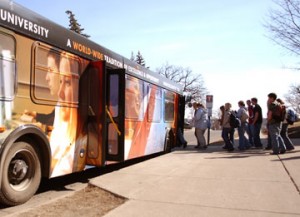By Katie Alvord
Abridged from Divorce Your Car: Ending the Love Affair with the Automobile
(New Society Publishers)
Let Someone Else Take You for a Ride
Buses, trains, car-sharing, carpools – whatever form it takes, shared transportation can give a big assist to car-free or car-lite living. Worldwide, transit plays a huge role in moving the human race. Even in car-dependent countries like the U.S., millions of people ride transit. All this travel has a range of advantages over using cars.
• Transit cuts congestion, pollution, and energy use. During World War II, when saving energy meant survival, governments encouraged use of transit and carpools as a way to conserve. “Fill those empty seats!” exhorted Uncle Sam posters. “Car sharing is a MUST!” Transit’s energy-saving potential is indeed high. In general, transit uses fewer British thermal units (BTUs) per passenger mile than do cars and light trucks. While a single-occupant car uses over 5,000 BTUs per passenger mile, a train car carrying 19 people uses about 2,300 and a bus carrying the same number only about 1,000.
Transit can also cut emissions. While some transit may be more polluting – diesel buses, for example, emit high levels of particulate matter – growing numbers of cleaner transit vehicles are far better. Buses powered by compressed natural gas (CNG), for instance, produce almost no particulate pollution. And putting more trains and buses in congested urban corridors cuts traffic and increases travel speeds for both transit riders and motorists. One full 40-foot bus will take 58 cars off the road; a six-car rail train can take 900 cars off the road.
• Transit saves land. Unlike freeways, which disperse development as sprawl, transit – especially rail – encourages compact development. This also saves money and energy and cuts pollution, since less sprawl requires less infrastructure. Where cities introduce rail, “an immediate process of urban consolidation begins,” write Australian transport experts Peter Newman and Jeff Kenworthy.
• Transit helps jobs and the economy. A study by Bates College economist David Aschauer showed that transit investments improve productivity possibly twice as much as road building. Aschauer’s conclusion: “Public transportation spending carries more potential to stimulate long-run economic growth than does highway spending.” Labor-intensive transit creates local jobs, and more of them. Spending a billion dollars on transit creates 7,000 more jobs than spending a billion on roads.
• Transit saves money.In 2007, transit users spent an average of about 21 cents per mile for travel, much less than the usual cost of a car; the American Automobile Association’s composite national average cost of driving in 2007 was 52.2 cents per mile, and this does not include parking or tolls. It’s possible to compare gasoline costs to transit fares and not see much difference, but that ignores the fixed costs of driving. With fixed costs included, transit comes out cheaper, and can even cost less than out-of-pocket driving expenses alone.
• Transit saves time, hassle – and lives. Leaving the driving to someone else might mean a longer trip overall, but you can spend the time doing something else: reading, writing a letter, catching up on work, having quality time with your kids. Sometimes, too, transit can be faster than driving by car. In 1993, Santa Barbara’s Metropolitan Transit District established an express bus route between Isla Vista (near the University of California) and Santa Barbara City College. The bus trip takes 30 minutes, reportedly less than driving. As word got out, the number of people taking this bus increased by 255% in two years.
Using transit frees you from responsibility for a car at either end of your journey. This means no time wasted hunting for parking, no concerns about feeding meters or getting parking tickets. Using transit can also mean traveling in a less tense, more serene atmosphere. Especially on trains, you can get up and move around as much as you want, a feature especially appreciated by children. And according to the National Safety Council, transit is one of the safest ways to travel. Where the average death rate per 100 million passenger miles is about 0.71 for autos, it drops to 0.05 for trains and 0.02 for buses.
• Transit restores community and equity.Transit can help restore community by bringing people out of metal-box isolation and into more contact with one another. Transit gives a wider range of people safe, independent mobility, helping integrate young, old, poor, disabled, and other non-drivers more fully into community life. And because of the way transit influences land use, it can help communities be more cohesive by nature of their compactness.
Overall, shared transportation is the most equitable way a society can provide mobility to people, regardless of income, age, and ability. It makes sense to advocate better transit service, not just for yourself but for the one-third of people – among them the old, young, and disabled – who don’t or can’t drive. The most important way you can advocate transit is to use it yourself. More people riding transit can help encourage more transit – and that means more opportunity to let someone else take you for a ride.

